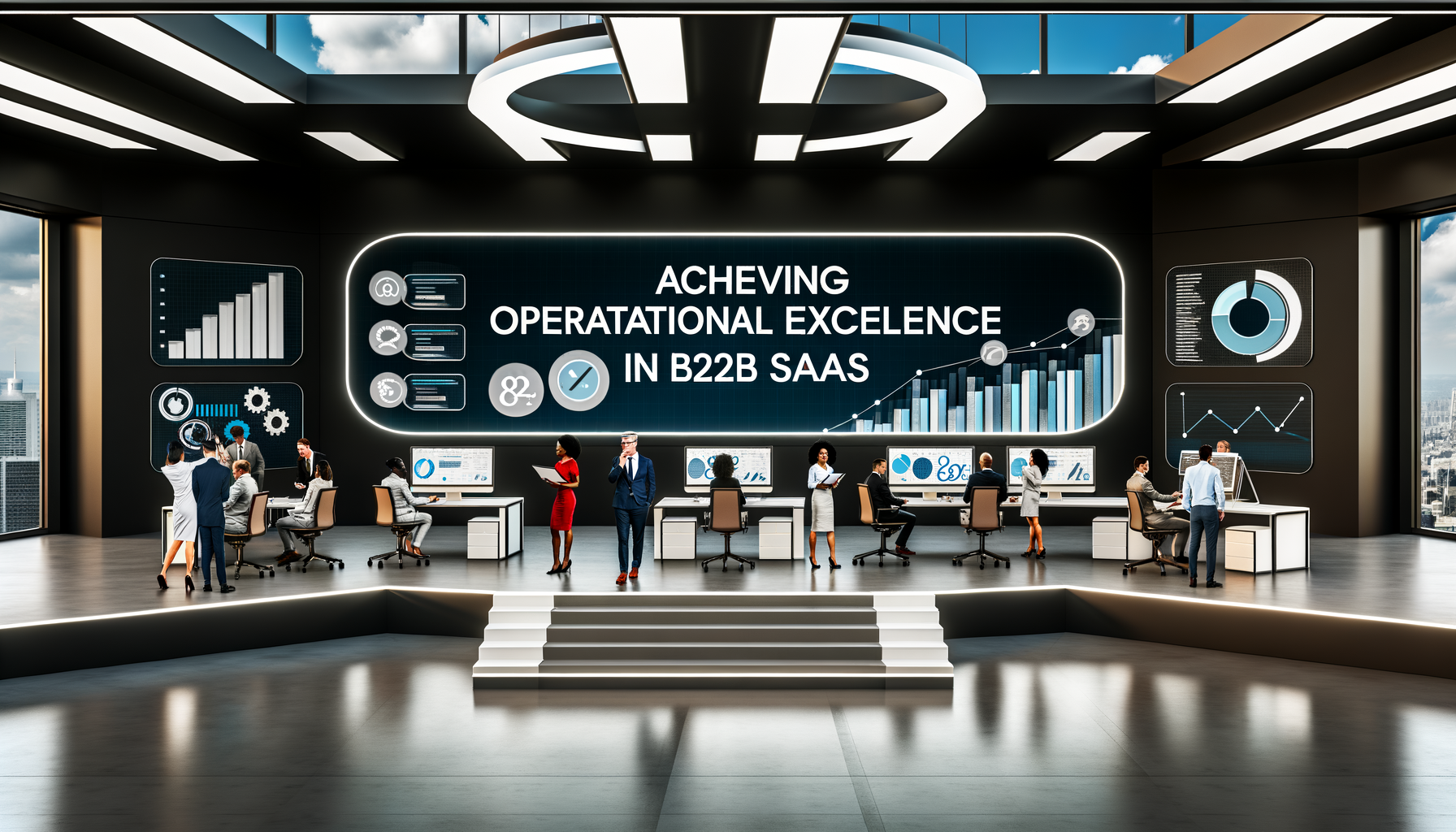
Achieving Operational Excellence in B2B SaaS
In the ever-evolving landscape of B2B SaaS, operational excellence is not just a buzzword; it’s an essential aspect of driving efficiency and improving customer satisfaction. The rapid advancements in technology and shifting client expectations make it crucial for B2B SaaS companies to fine-tune their operations continuously. In this article, I’m going to delve into how B2B SaaS businesses can achieve operational excellence, ensuring that their processes are streamlined and their clients are satisfied.
Understanding Operational Excellence in B2B SaaS
Operational excellence in B2B SaaS is all about orchestrating system-wide efficiencies that allow your organisation to deliver value to customers while maximizing resources. It’s a commitment to creating a company culture that prioritizes continuous improvement and problem-solving. Through this approach, businesses can reduce waste, lower costs, and enhance overall performance.
Setting Clear Objectives and KPIs
To begin, it’s critical to establish clear objectives and measurable Key Performance Indicators (KPIs). This foundational step ensures everyone in the organisation understands what operational excellence looks like and how it is measured. The objectives should focus on both efficiency and customer satisfaction.
- Define your short-term and long-term goals.
- Identify metrics that directly affect these goals – such as churn rate, customer lifetime value, and operational costs.
- Regularly review and adjust these KPIs as your business grows and evolves.
Embracing Lean Principles
Embracing lean methodologies can significantly enhance your company’s operational efficiency. Lean principles focus on value addition from the customer’s point of view and aim to eliminate waste throughout the process.
- Value Stream Mapping: Visualize the entire process to identify where value is added and where inefficiencies lie.
- Continuous Improvement: Encourage a culture where employees at all levels are empowered to suggest improvements.
- Standardization: Implement standard processes to maintain quality and efficiency across different teams.
Leveraging Technology for Enhanced Efficiency
In B2B SaaS, the strategic deployment of technology is vital for achieving operational excellence. Here’s how technology can be a game-changer:
Automation of Routine Tasks
Automation is no longer a luxury; it’s a necessity. By automating repetitive and mundane tasks, you not only free up your team to focus on more strategic work but also reduce the likelihood of errors. Whether it’s automating client onboarding or streamlining customer support, harnessing automation tools can dramatically increase operational efficiency.
Data-Driven Decision Making
The ability to make informed decisions using data is transformative. With advanced analytics tools, B2B SaaS companies can tap into customer usage patterns, identify service bottlenecks, and predict future trends effectively.
- Implement dashboards: Use data visualization to keep track of performance metrics and operational health.
- Predictive analysis: Leverage historical data to forecast demand and potential challenges.
- Feedback loops: Regularly solicit customer feedback and integrate insights to refine services.
Nurturing a Customer-Centric Approach
In SaaS, customer satisfaction is a reflection of operational success. Here’s how a customer-centric approach can lead to excellence:
Proactive Customer Service
Developing a proactive customer service mindset means anticipating issues and offering solutions before customers need to ask. This can be achieved through regular communication, personalized interactions, and swift problem resolution.
Customer Feedback as a Growth Tool
Active solicitation of customer feedback can uncover product shortcomings and improvement areas. It’s essential to not only gather feedback but also act on it, closing the loop with clients by demonstrating how their input leads to enhancements.
Building a Collaborative Company Culture
Operational excellence is as much about people as it is about processes. Building a collaborative environment where team members are encouraged to collaborate and contribute to process improvements is critical.
Fostering Team Alignment
Ensure all teams understand the company’s strategic vision and how their roles contribute to achieving it. Regular cross-departmental meetings and workshops can keep everyone aligned and foster an environment of shared goals.
- Encourage cross-functional projects: Break down silos and promote a shared sense of purpose.
- Recognize and reward innovation: Create incentives for team members who contribute to operational improvement initiatives.
- Invest in training: Providing continuous learning opportunities equips your team to adapt and innovate.
Conclusion: Embarking on the Journey to Operational Excellence
Achieving operational excellence in B2B SaaS is not a one-off task but a continuous journey. It requires setting clear goals, prioritizing efficiency, leveraging the right technology, and keeping the customer at the heart of your operations. By adopting a holistic approach to improving operations, not only do you enhance efficiency, but you also pave the way for superior customer satisfaction. I invite you to explore more insights and strategies shared on Foundercrate, where I chronicle this transformative journey and share valuable lessons from my entrepreneurial experiences.

Risk Management Strategies for FinTech Startups
Navigating the tumultuous waters of the financial technology sector requires not just innovation and agility, but a keen sense of risk management. As a founder of a FinTech startup, the potential for growth is tantalizing, yet the risks can be overwhelming if not strategically addressed. Here is a comprehensive exploration of effective risk management strategies specifically tailored for FinTech startups.
Understanding the Unique Risks in FinTech
FinTech is a continuously evolving domain that integrates finance and technology, and with great opportunity comes significant risk. These risks include regulatory challenges, cybersecurity threats, operational risks, and financial exposure. Each risk, without appropriate management, can impact the viability and reputation of a startup. Therefore, defining and understanding these risks are the first critical steps towards effective management.
Regulatory Compliance: The Backbone of Risk Management
Staying compliant with ever-changing regulations is paramount for FinTech startups. This requires a proactive approach, such as:
- Regular Audits: Conducting frequent audits can identify compliance gaps and areas for improvement.
- Regulatory Technology (RegTech): Leveraging technology solutions to simplify compliance processes, reduce human error, and enhance accuracy.
- Legal Consultation: Having a legal expert or team well-versed in financial regulations ensures informed decision-making and strategizing.
Mitigating Cybersecurity Threats
Cybersecurity is one of the most pressing concerns for any FinTech entity. The threat of breaches can have far-reaching consequences. In tackling these cybersecurity threats, I employ robust strategies including:
- Encryption: Ensuring sensitive data is protected through advanced encryption methods makes it inaccessible to unauthorized parties.
- Regular Penetration Testing: Routine tests to find vulnerabilities help in fortifying security defenses.
- Education and Training: Continuous training for staff on recognizing and dealing with potential threats is crucial for a unified security front.
Operational Risk Management
Operational pitfalls can include anything from inefficient processes to human error. Here’s how I mitigate these:
- Process Automation: Automating routine tasks reduces human error and increases efficiency.
- Business Continuity Planning (BCP): Having a Plan B for operations ensures that the startup can continue functioning even when unplanned disruptions occur.
- Risk Assessment Frameworks: Implementing frameworks that continuously identify and manage operational risks is essential for long-term sustainability.
Financial Exposure and Strategic Planning
Financial risk is inherent to any business, especially in volatile sectors like FinTech. To address this, I focus on:
- Cash Flow Management: Meticulous management of funds ensures liquidity and financial stability during difficult times.
- Diversification: Avoiding over-reliance on a single revenue stream provides a buffer against market changes.
- Insurance: Appropriate financial insurance products can safeguard against catastrophic financial losses.
Leveraging Technology for Effective Risk Management
In today’s digital age, technology serves as an invaluable ally in risk management. With innovations like Artificial Intelligence and Machine Learning, it’s possible to automate risk analyses and gain predictive insights, thereby staying one step ahead. Utilizing these technologies can help refine and strengthen risk management processes.
Conclusion: Strong Foundations for Future Success
The landscape of FinTech is fraught with potential hazards, but with diligent risk management practices, these challenges can be transformed into opportunities for growth. By implementing these strategies, FinTech startups can navigate risks efficiently and lay sturdy foundations for future success. For those looking to delve deeper into effective management practices or seeking insights from my experiences in the startup ecosystem, I invite you to connect and explore further insights with me.

Leveraging AI for Personalized Customer Experiences in SaaS
In today’s fast-paced digital world, personal connection can often feel elusive, even when it comes to how businesses interact with customers. This growing gap has led to a surge in demand for personalized customer experiences—especially within the Software as a Service (SaaS) industry. With the advent of Artificial Intelligence (AI), we have an unparalleled opportunity to bridge that gap in truly innovative ways.
The Power of Personalization
Why is personalization becoming a critical aspect of SaaS solutions? Simply put, customers expect recognition and relevance at every digital touchpoint. They desire a unique experience that resonates with their individual needs and preferences. Personalization helps to enhance user satisfaction and foster loyalty by showing customers that companies understand and value them, turning interactions into deeper relationships.
However, delivering such highly customized experiences has traditionally been resource-intensive and prone to inconsistency. That’s where AI steps in as a game-changer.
AI: The Catalyst for Personalized Experiences
The incorporation of AI technologies into SaaS platforms isn’t just an upgrade; it’s a transformation. AI helps drive personalization by enabling businesses to analyze vast data sets quickly, identify patterns, and predict future behaviours, thereby creating tailored experiences for each user.
Here’s how AI can be leveraged to refine customer experiences:
- Data Analysis and Interpretation: AI algorithms can sift through real-time data far more efficiently than traditional methods. By understanding customer behaviours, preferences, and interactions, SaaS providers can offer customized recommendations and content.
- Dynamic Content Personalization: AI allows for the delivery of dynamic content, adjusting automatically based on user interactions. This ensures relevant information is pushed to the forefront, aligning with the customer’s evolving needs.
- Proactive Customer Support: Chatbots and AI-driven customer support can preemptively address user issues by analyzing past interactions and predicting potential problems, offering solutions before issues escalate.
- Predictive Insights: AI captures trends and predicts future user needs, enabling SaaS platforms to introduce relevant features or services that address those upcoming demands.
Case Studies: Success and Innovation
To illustrate the tangible impact of AI in SaaS, let’s delve into a couple of real-world applications. These examples showcase how personalization can drastically alter customer experiences:
- NetSuite: By incorporating AI technologies, NetSuite has managed to streamline customer resource management. This not only enhances efficiency but also empowers personalized dashboards that cater specifically to each user’s operational needs.
- Salesforce Einstein: This AI layer provides actionable insights drawn from complex data sources, enabling businesses to offer hyper-personalized experiences that boost user engagement and adoption rates.
Addressing Challenges
While the potential of AI in personalizing customer experiences is immense, it comes with its set of challenges that businesses need to address strategically. Privacy concerns are forefront since personalized experiences require substantial user data. It is crucial to adopt robust data privacy and protection measures to ensure trust and compliance.
Moreover, AI integration needs an initial investment in technology and expertise. It requires time to explore what personalization techniques will offer the most significant return on investment and make strategic adjustments as required.
The Road Ahead
As we forge ahead into a new era where experiences are crafted and enriched by technological prowess, it’s critical for us to remain focused on creating genuine value for customers. AI’s role in the SaaS space is transformative, enabling us to craft personalized experiences that lead to higher customer satisfaction and loyalty.
As technology evolves, we must stay agile and receptive to innovation in order to maintain an edge in this ever-competitive market. By embracing AI, we’re not only improving customer experiences but also fostering a culture of innovation and continuous improvement.
If you’re as excited about the possibilities as I am, I invite you to explore the world of AI-driven personalization with me. Together, we can navigate this dynamic landscape, utilizing AI’s capabilities to meet and exceed customer expectations, paving the path for sustainable success in SaaS.

Entrepreneurial Well-being: Balancing Physical and Mental Health
Embarking on the journey of entrepreneurship is exhilarating yet demanding, and it’s no secret that the path is fraught with challenges—many that can take a toll on one’s health. Balancing the drive to succeed with personal well-being is not only essential for sustained performance but also for maintaining a sense of fulfillment on both professional and personal fronts.
Understanding the Importance of Well-being for Entrepreneurs
As founders, the pressure to excel often overshadows the need to take care of our own well-being. It’s tempting to forgo sleep, meals, or exercise in favour of meeting deadlines or seizing new opportunities. However, this imbalance can gradually lead to burnout, decreased productivity, and even a loss of passion for the venture itself.
What I’ve learned through my own entrepreneurial journey is that a holistic approach that values both physical and mental health can dramatically enhance performance and satisfaction. The key is in developing strategies that support our well-being, enabling us to thrive in the demanding world of entrepreneurship.
Physical Health: The Foundation of a Strong Entrepreneur
Physical health forms the bedrock upon which we build our entrepreneurial dreams. It influences our energy levels, resilience to stress, and cognitive function. Here’s how I incorporate it into my routine:
1. Prioritize Consistent Exercise
Whether it’s a full-on workout session or a simple daily walk, consistent physical activity is a non-negotiable aspect of my life. Exercise releases endorphins, which are natural mood lifters, and helps in maintaining stamina crucial for long hours of work.
For those looking to integrate physical activity, the secret lies in choosing something enjoyable. It makes continuity easier and transforms exercise from a chore into a source of enjoyment.
2. Nutrition and Hydration: Fuel for Success
The food and drinks we consume directly affect our productivity and mood. I aim to maintain a balanced diet rich in nutrients, steering clear of processed foods and excessive caffeine that can contribute to energy crashes and mood swings.
Remember, proper hydration is just as vital. Keeping hydrated improves focus, boosts energy, and even enhances physical endurance, factors that entrepreneurs desperately need to stay at their best.
Mental Health: Sustaining the Entrepreneurial Spirit
An entrepreneur’s journey is often a rollercoaster of highs and lows. Managing mental health effectively ensures we stay grounded and resilient in the face of adversity. Here are some practices that have become pillars in my routine:
1. Mindfulness and Meditation
Incorporating mindfulness practices such as meditation helps manage stress and reduces anxiety, which are common companions of startup life. Even just a few minutes of focused breathing each day clears the mind and enhances decision-making.
2. Stay Connected and Seek Support
Entrepreneurship can sometimes feel like a lonely road. Building a network of supportive peers, mentors, and friends ensures that I have outlets for guidance, companionship, and encouragement. Whether it’s a mastermind group or an informal coffee with a fellow founder, these interactions provide valuable perspective and support.
3. Professional Help When Needed
There should be no stigma in seeking professional help from therapists or coaches. They offer objective insights that can help us untangle complex mental and emotional hurdles. I’ve found that having a mental health professional as part of my support network is an invaluable asset in high-pressure times.
Creating a Balanced Routine for Optimal Performance
Balance doesn’t imply a rigid 50-50 split; instead, it’s about ensuring that all areas of well-being receive attention proportionate to their needs. Here’s how I maintain that balance:
- Schedule regular breaks and downtime to recharge.
- Set boundaries to differentiate between work and personal time.
- Implement time and task management strategies to enhance efficiency.
- Regularly reassess priorities to align with personal and business goals.
Conclusion: Thrive by Prioritizing Your Well-being
The notion of the ‘workaholic entrepreneur’ might sound compelling, but true success stems from a sustainable approach. By prioritizing our well-being alongside our entrepreneurial ambitions, we not only enhance our performance but also ensure that the entrepreneurial journey remains a fulfilling one.
As we continue on this exciting path, I encourage all entrepreneurs to actively pursue strategies that nurture both mind and body. Stay committed to these practices, and let’s pave a healthier, more balanced road to success together. Feel free to connect for more insights and tips on entrepreneurial well-being, and remember you’re not alone on this journey.

Navigating Data Security in a Remote Work Environment
In today’s fast-paced and increasingly digital world, the shift towards remote work has brought about numerous benefits, from increased flexibility to the ability to tap into a global talent pool. However, with these advantages come significant challenges, particularly in the realm of data security. As someone deeply entrenched in the world of startups and technology, I’ve seen firsthand how crucial it is to navigate these challenges effectively. The security of our digital assets is paramount, and as we venture further into a remote-centric workspace, understanding and addressing these data security issues becomes not just important, but imperative.
The Growing Remote Work Trend
The trend towards remote work isn’t just a temporary phase; it’s a transformation in the way businesses operate on a global scale. More companies are recognising the benefits, and employees are demanding it. But as this trend grows, so too do the security risks associated with managing sensitive data outside the traditional office environment. It’s critical to prepare and adapt our security strategies to protect against potential breaches and data loss.
Data Security Challenges in Remote Work
Let’s face it, the transition to remote work isn’t a seamless process for many businesses, particularly when it comes to safeguarding data. Here are some of the primary challenges I’ve identified:
- Unsecured Networks: Many employees end up using their home networks to access company data. Unlike corporate networks, these are often insufficiently secured, increasing the vulnerability to attacks.
- Device Security: As remote workforces rely on personal devices, ensuring these devices are secure is a real hurdle. Companies must tackle issues related to the lack of corporate control over personal desktops and laptops.
- Data Access: Granting employees access to necessary data while ensuring that such access is monitored, justified, and secure is crucial. Mismanagement here could lead to unauthorized access and data breaches.
- Lack of Cybersecurity Training: Employees unaware of basic cybersecurity principles might unintentionally click on phishing links or download malware, jeopardizing company data.
Strategies to Enhance Data Security
Having identified the challenges, the next step is to strategize around them. Here’s how businesses can bolster their data security protocols:
1. Implement Robust Security Measures
While working remotely, robust security measures such as VPNs, firewalls, and encryption become non-negotiable. These tools help secure data in transit and shield it from unauthorized access.
2. Encourage and Implement Multi-Factor Authentication
Employers should insist on multi-factor authentication (MFA) for all applications and data access points. MFA adds an extra layer of security, making it harder for cybercriminals to gain access.
3. Regularly Update Software and Systems
Staying current with software updates and security patches is critical in combating vulnerabilities. Companies should enforce a policy of regular updates across all employee devices.
4. Educate and Train Your Team
Education is key. Employees should be made aware of security best practices and trained to recognise phishing attempts. Regular cybersecurity training sessions can significantly reduce the risk of human errors.
Creating a Culture of Security
Data security isn’t just a technical issue; it’s a cultural one. Encouraging a security-first mindset across your company can vastly improve your resilience against breaches. This begins from the top-down, where leadership demonstrates a commitment to data security by investing in resources and policies that safeguard information.
Conclusion
In navigating the intricacies of remote work, data security stands as a formidable challenge. Yet, by understanding these challenges and crafting a strategic response, businesses can protect their critical information and maintain their reputation in the digital space. As we continue to embrace the remote work model, I encourage my fellow entrepreneurs and business leaders to stay vigilant, informed, and proactive. The security of our data and, ultimately, our businesses depend on it. For more insights and resources on data security, feel free to explore more on our platform and join me in this crucial conversation.

The Science of Execution: Processes and Tools
Stepping into the world of business, you quickly learn that ideas are only as valuable as their execution. The art, or rather the science, of getting things done efficiently is what sets a thriving business apart from one that merely survives. It’s about turning dreams and plans into reality through structured processes and a toolkit that supports seamless operations. If you’re keen on deciphering the science of execution and ready to elevate your operational efficiency, this exploration into processes and tools will guide you through the essentials every entrepreneur should master.
Unpacking Execution Science: More Than a Buzzword
Execution science might sound like a buzzword, but it’s a critical aspect of business success. It refers to the systematic approach of transforming strategies into actions and results. This requires a deep understanding of both processes and tools that enable efficient task management and decision-making. As a founder, recognizing and harnessing the mechanisms behind execution science can significantly enhance operational efficiency and productivity.
Understanding Core Processes
Every business has foundational processes that drive daily operations. Understanding and optimizing these processes is vital to improving execution efficiency. Here’s what you need to focus on:
- Workflow Management: Define clear steps for tasks and projects, assigning responsibilities and setting deadlines to keep things moving smoothly.
- Resource Allocation: Ensure that your resources, whether human or capital, are utilized effectively by prioritizing tasks aligned with strategic goals.
- Performance Monitoring: Implement metrics to track progress and outcomes, allowing you to make real-time adjustments for optimization.
By embedding robust processes into your organizational structure, you create a reliable framework that supports strategic execution.
The Tools of the Trade
Having the right tools is indispensable in executing strategies efficiently. Here’s a rundown of some essential tools that support execution science:
- Project Management Software: Tools like Asana and Trello offer platforms to manage tasks, collaborate with teams, and keep track of project timelines effectively.
- Communication Platforms: Utilizing Slack or Microsoft Teams ensures continuous and clear communication, essential for executing tasks without hiccups.
- Data Analytics: Tools like Google Analytics help in decision-making by providing insights into performance and areas of improvement.
These tools are not just about technical capability; they instill discipline and consistency in executing tasks, which together form a backbone for success.
Incorporating the Science of Execution in Daily Operations
Seeing ideas through to fruition requires a seamless incorporation of both processes and tools into the daily grind of business operations. Here’s how to make it a part of your everyday workflow:
- Continuous Learning and Adaptation: Stay updated with the latest trends in execution science and be ready to adopt processes and tools that can offer efficiency improvements.
- Empowerment Through Training: Regular training ensures your team knows how to utilize processes and tools effectively for maximum productivity.
- Cultural Alignment: Embed a culture where structured execution is valued just as highly as ideation.
By championing execution science in everyday activities, you not only improve current operations but also set the groundwork for scalable future growth.
Conclusion: Elevate Your Execution Game
The potential of a business lies in its capability to execute plans with precision and efficiency. This requires not just a strong understanding of processes and tools but also an unwavering commitment to continually refining them. As I continue on my entrepreneurial journey, I encourage you to delve deeper into execution science, ensuring every aspect of your business is primed for efficiency and success. Together, let’s transform visionary ideas into tangible successes through the science of execution.
To stay ahead in the ever-evolving business landscape, feel free to connect with me for more insights or explore Foundercrate for resources designed to guide you on this journey.

Financial Forecasting for Sustainable Business Growth
Unlocking the Potential of Financial Forecasting for Business Sustainability
In the ever-competitive world of entrepreneurship, mastering financial forecasting isn’t just an option; it’s a necessity. We live in an era where unpredictable market dynamics demand that business leaders constantly adapt and optimize their strategies. As an entrepreneur looking to scale sustainably, understanding the pivotal role of financial forecasting helps in steering clear of unexpected pitfalls while driving growth.
The Role of Financial Forecasting in Business Strategy
Financial forecasting serves as a crucial compass in the business planning landscape, shedding light on the economic path ahead. It involves predicting future revenues, expenses, and financial conditions to develop a viable plan for growing a business sustainably.
- Predicting Financial Health: By anticipating future sales and expenses, businesses gain insights into their potential cash flow and liquidity positions.
- Evaluating Growth Opportunities: Financial forecasts help in assessing the feasibility of expansion plans or launching new product lines.
- Mitigating Risks: Forecasting identifies financial risks, enabling proactive strategies to address potential cash shortages or losses.
- Guiding Investment Decisions: Well-articulated financial predictions provide the reassurance needed for investors, steering more informed fundraising activities.
Key Ingredients for Accurate Financial Forecasts
Creating reliable financial forecasts requires a blend of historical data, market trends, and strategic assumptions. Here’s how I leverage each to underpin sustainability and growth:
Leveraging Historical Data
The first stepping stone in financial forecasting involves analyzing your past performance. Historical data provides the foundational insights from which we identify trends, seasonality effects, and recurring expenses. By understanding our business’s historical patterns, I can make educated predictions about future performance.
Monitoring Market Trends
A keen eye on industry trends and economic indicators supplements historical data analysis. This includes keeping track of competitor moves, emerging technologies, and shifts in consumer behaviour. Having a comprehensive understanding of these elements places me in an advantageous position to anticipate market demands and adjust strategies accordingly.
Articulating Strategic Assumptions
Forecasting isn’t just about numbers; it’s about envisioning the scenarios that shape those numbers. This involves making strategic assumptions—on market entry, regulatory impacts, or potential partnerships. By incorporating diverse scenarios, I can better prepare the business to thrive in varied environments, fostering sustainable growth.
Emphasizing Sustainability in Financial Planning
Sustainability isn’t merely a buzzword—it’s a principle that should drive every conscientious entrepreneur’s financial planning. Financial forecasting allows me to adopt sustainability by integrating:
- Resource Allocation: Directing funds toward renewable energy solutions or community initiatives helps build a positive brand identity while securing long-term operational viability.
- Operational Efficiencies: Identifying areas ripe for process improvements not only reduces costs but enhances the business’s overall efficiency and sustainability.
- Profit and Impact Alignment: Balancing profit motives with societal impacts ensures that growth doesn’t come at the expense of our planet’s health or social equity.
Pitfalls to Avoid in Financial Forecasting
Despite its critical role, financial forecasting can lead to detrimental errors. My experience in entrepreneurship has taught me to remain vigilant about the following missteps:
Overly Optimistic Projections
Hope and ambition are great drivers of innovation, but in financial forecasting, they can lead to peril. Overestimating revenue growth or underestimating costs easily results in budgetary gaps.
Ignoring External Influences
Constantly evolving external dynamics—be it geopolitics or sudden market shifts—cannot be sidelined. Factoring these into your forecasts ensures better preparedness and stability in growth.
Conclusion: Navigating Growth with Financial Foresight
Financial forecasting in business planning is much like navigating a ship through turbulent waters; it enables me to make well-informed decisions that underpin sustainable business growth. By blending historical analysis, keen market observations, and strategic foresight, I can anticipate challenges and steer clear of needless risks. This comprehensive understanding is a cornerstone in crafting robust strategies that not only foster growth but do so in a manner aligned with broader social and ecological goals. For more insights and to join me on this journey toward sustainable entrepreneurship, feel free to explore the myriad resources, case studies, and expert insights available through Foundercrate.

Strategic Partnerships: Driving Growth in B2B SaaS
In today’s competitive landscape, forming strategic partnerships can be a game-changer for B2B SaaS businesses. The key to unlocking growth often lies in aligning with the right partners, complementing each other’s strengths, and reaching shared goals more efficiently. Having navigated the nuances of the startup world, I’ve discovered how invaluable these alliances can be in driving innovation, expanding market reach, and enhancing customer value.
Understanding Strategic Partnerships in B2B SaaS
Strategic partnerships in the B2B SaaS sector go beyond mere collaborations; they represent a synergy that allows two companies to leverage collective strengths. Whether it’s integrating technologies, co-developing products, or sharing distribution channels, the right partnership amplifies resources and accelerates growth. It’s essential for such alliances to be mutually beneficial, with clear objectives and aligned visions.
Key Benefits of Strategic Partnerships
Forming a strategic partnership in the B2B SaaS space offers several advantages:
- Access to New Markets: By partnering with a company that already has an established presence in a target market, businesses can penetrate new territories without having to start from scratch.
- Resource Sharing: Partnerships enable the sharing of technological resources, expertise, and insights, reducing the time and cost to innovate and scale.
- Enhanced Value Proposition: Through collaboration, companies can offer enhanced or bundled solutions, increasing the overall value proposition to customers.
- Strengthened Competitive Position: A well-aligned partnership can differentiate your offering in a crowded market, positioning your business ahead of competitors.
Successful Partnership Strategies
To make the most out of strategic partnerships, a well-crafted strategy is imperative. Here’s what has worked best for me and may for you as well:
Identify Synergies
Before sealing any partnership, understand how the combined strengths of both parties will create value. Look for synergies in technology, market coverage, and brand influence. This alignment is critical to delivering mutual benefits and achieving strategic objectives.
Clear Communication and Shared Goals
Open communication channels are a cornerstone of successful partnerships. Regular meetings and updates ensure all partners stay on the same page, aligning strategies with shared goals. Documenting partnership objectives and success metrics can help streamline efforts and predict potential risks.
Flexible and Scalable Agreements
Design agreements with flexibility in mind to allow room for growth and adaptation as market or technological conditions change. Include provisions that are scalable, enabling partners to expand the scope of collaboration as needs evolve.
Examples of Winning B2B SaaS Partnerships
Examples of winning partnerships are plentiful in the B2B SaaS space. Companies like Salesforce have mastered this art by continuously forming alliances that extend its CRM capabilities across numerous industries. Similarly, Slack’s partnership with Zoom showcases how integrating communications tools can enhance remote work solutions, offering seamless productivity to users.
Challenges to Overcome
While strategic partnerships offer a path to growth, they are not without challenges:
- Misaligned Objectives: One partner may prioritize revenue while the other focuses on market share, potentially leading to conflicts.
- Cultural Differences: Different corporate cultures can hinder collaboration if not managed properly.
- Dependence Risks: Relying heavily on one partner may create vulnerabilities should the partnership dissolve.
Conclusion: Driving Growth Through Collaboration
Strategic partnerships are undeniably powerful for driving growth in B2B SaaS businesses. They provide a structured pathway to share resources, reap collaborative benefits, and explore new markets. Whether through product innovation, enhanced market reach, or improved customer solutions, partnerships foster growth that might not be achievable independently. As we continue to build and innovate at Foundercrate, I keep these partnership principles at the core, and I encourage other entrepreneurs to explore and leverage these collaborative opportunities. If you’ve found this exploration valuable, join our community to dive deeper into the world of strategic startups and fundraising insights.

AI Trends Shaping the Future of SaaS
In the dynamic world of Software as a Service (SaaS), AI is not just the latest buzzword—it’s a transformative force reshaping the industry as we know it. My journey through the ever-evolving landscape of entrepreneurship and technology has taught me that innovation is key to staying ahead. Today, I’ll dive into the world of AI trends that are propelling the future of SaaS and how they can be leveraged for competitive advantage.
Understanding the AI Revolution in SaaS
To start, let’s establish the significance of AI in SaaS. Artificial Intelligence isn’t just about robots or futuristic sci-fi scenarios; it’s about creating smarter, more intuitive solutions that enhance user experiences, streamline operations, and drive scalability. Companies leveraging AI are setting themselves up for long-term success in an increasingly competitive market.
Automated Personalization: Enhancing User Experience
One of the most promising AI trends in SaaS is automated personalization. By leveraging vast amounts of user data, AI algorithms can analyse patterns and preferences to deliver highly personalized experiences. Imagine a CRM system that not only monitors client interactions but anticipates their needs before they even articulate them. This capability moves beyond traditional customization, creating a unique experience for each user. Personalization is no longer a luxury—it’s a necessity for staying relevant.
Integrating AI for Process Automation
SaaS companies are increasingly adopting AI to automate routine operational tasks. From billing and invoicing to customer support and human resources, AI streamlines these processes, significantly reducing operational costs. By implementing AI-driven chatbots and virtual assistants, businesses can handle customer inquiries instantaneously, 24/7. This frees up human resources to focus on more strategic tasks, enhancing overall productivity.
Predictive Analytics for Informed Decision-Making
Data-driven decision-making is no longer an optional strategy; it’s a vital operational cornerstone. AI-driven predictive analytics offer SaaS businesses invaluable insights by predicting market trends, customer behaviors, and operational inefficiencies. These insights enable businesses to make informed, strategic decisions that drive growth and efficiency. By spotting opportunities and threats ahead of time, businesses can navigate the complex SaaS market landscape with confidence.
Innovative Approaches: AI-Enhanced Cybersecurity
In a digital age where data security is paramount, AI is emerging as a critical player in safeguarding sensitive information. AI-driven security systems can analyze network traffic for anomalous patterns, identifying potential threats before they manifest. The ability to predict and prevent breaches is becoming a non-negotiable asset for any SaaS provider wanting to maintain client trust and ensure compliance with data regulations.
Moving Forward: Strategies for Adapting AI in SaaS
As we consider these transformative trends, the question remains: How do SaaS businesses effectively adapt AI? Here are a few steps based on my experience:
- Prioritize Data Collection: Ensure robust data collection systems are in place to gather the quality and quantity of data necessary for AI analysis.
- Stay Updated: AI technology is rapidly evolving. Regularly staying informed through industry blogs, webinars, and conferences can keep your business ahead.
- Invest in Talent: Hire or upskill your workforce to ensure they have the expertise to implement and manage AI technologies effectively.
- Focus on Integration: AI should not be an isolated solution. Integrate AI across different processes for a cohesive, company-wide improvement.
Conclusion: Embracing the AI-Empowered Future of SaaS
In wrapping up, AI presents endless possibilities for the SaaS industry. Embracing these AI trends is no longer an option; it’s a strategic imperative. As an entrepreneur, leveraging AI can pave the way for not only survival but thriving in a competitive and ever-evolving tech landscape. To explore more insights on how these transformative technologies can be applied to your own entrepreneurial journey, follow my updates, and together, let’s unlock the full potential of AI in SaaS.

Mindfulness Techniques for Stress Reduction in Entrepreneurship
Finding Calm Amidst the Chaos: A Personal Journey with Mindfulness in Entrepreneurship
As an entrepreneur deeply entrenched in the excitement and challenges of startup life, I know firsthand how stress can entrench itself in our daily routines. Balancing innovation, fundraising, and team dynamics can often feel overwhelming. This is why I turned to mindfulness techniques not merely as stress reducers but as life savers in maintaining equilibrium and enhancing focus.
Embracing Mindfulness for Effective Stress Reduction
Stress is an ever-present companion in entrepreneurship. It’s critical to address it head-on to prevent burnout. Mindfulness, in this context, stands as a powerful tool. It transforms stress into a manageable element by encouraging us to stay present and aware. Let me share how integrating mindfulness in my daily routine has significantly altered my approach to these challenges.
The Essence of Mindfulness in Daily Practice
Mindfulness is more than a buzzword; it’s a state of active, open attention to the present moment. When running a business, I often found myself either worrying about the future or dwelling on past decisions. Shifting focus back to the present moment has been pivotal. By engaging fully in the here and now, I’ve noticed a marked improvement in my stress levels.
Here’s how I incorporate mindfulness into my workload:
- Mindful Breathing: Setting aside a few minutes to practice deep, controlled breathing helps regulate emotional response and clear mental fog.
- Body Scan Meditation: This involves tuning into different parts of my body, releasing tension, and nurturing a stronger mind-body connection.
- Mindful Walking: Taking short breaks during the day to walk mindfully, focusing solely on the act of walking, proves surprisingly refreshing.
Enhancing Focus through Mindful Practices
Another profound benefit of mindfulness in entrepreneurship is its capacity to bolster focus. Multitasking might seem necessary, yet it often fragments our attention. By cultivating mindfulness, I’ve learned to sharpen my focus, directing my attention intentionally.
Mindfulness Techniques for Enhanced Focus
Adopting these practices has allowed me to sift through the noise, ensuring that my energies are devoted to the most pressing priorities:
- Single-Tasking: Instead of juggling multiple tasks, I now concentrate on completing one job at a time with full attention.
- Mindful Listening: In meetings, I practice active listening, fully engaging with others to understand and engage more meaningfully.
- Visualization Techniques: Spending time visualizing outcomes and brainstorming in a calm, centered manner contributes to clearer strategy formation.
The Entrepreneurial Well-being: A Commitment to Health
Nurturing mental health has become an integral part of my growth as an entrepreneur. Undoubtedly, our journeys are unique, yet the fundamental need for emotional balance persists across all endeavors. Stress reduction through mindfulness isn’t a quick fix but a long-term commitment and, from my experience, an invaluable investment in well-being.
Committing to Change
Integrating mindfulness into business can appear daunting initially, particularly amidst a packed schedule. However, the journey of a thousand miles begins with a single step, and introducing just one mindful practice can profoundly impact stress levels and overall focus.
For those keen to embark on this path, check out our comprehensive guide on mindfulness for entrepreneurs, or explore the benefits of mindfulness in how it can transform your startup.
Conclusion: Inviting Mindfulness into the Entrepreneurial Ecosystem
As I reflect upon the impacts of mindfulness, it’s clear that cultivating mindfulness skills isn’t merely a survival strategy but a thrival strategy. We stand the best chance of growing better, more resilient businesses by prioritizing our mental health. I invite you to explore these practices and witness their effects firsthand. Follow along, stay informed, and embark on this journey with me as we integrate mindfulness into the very core of our entrepreneurial endeavors.
